Scleroderma
What is Scleroderma?
Scleroderma is a chronic, autoimmune condition in which normal tissue is substituted with dense, thick fibrous tissue. Generally, the immune system helps to protect the body against illness and infection.
In a person with scleroderma, the immune system activates further cells to create too much collagen (a protein). This additional collagen is deposited in the skin and organs, which generates hardening and thickening (equal to the scarring process).
Although it most frequently involves the skin, scleroderma also can involve many other regions of the body involving the gastrointestinal tract, kidneys, lungs, blood vessels, heart, muscles, and joints. Scleroderma in its most extreme conditions can be life-threatening.
Synonyms
- Progressive systemic sclerosis
- Systemic sclerosis
- Limited scleroderma
- CREST syndrome
- Localized scleroderma
- Morphea – linear
- Raynaud’s phenomenon – scleroderma
Epidemiology
Scleroderma is a rare condition. Its majority differs in ethnicity, gender, and geographic region. In France, the calculated incidence of systemic sclerosis was 158.3 per million in 2002, mainly defined as the cutaneous forms. The prevalence of the condition in Detroit was 242 patients per million grown-ups with an annual incidence of 19.3 new patients per year per million grown-ups over the period 1989-91. As in multiple other autoimmune conditions, females are at higher risk than males (ratio 4.6:1). Systemic scleroderma can happen at any age; yet, it is infrequent in kids and the elderly. The condition is most prevalent in people aged 30-50 years.
Localized scleroderma involves mostly females with an incidence of 3 cases per 100,000 individuals/year. Plaque form (also known as morphea) is more prevalent in grown-ups while linear scleroderma involves mostly kids
Types of Scleroderma
There are 2 main forms of scleroderma, one is localized and the second is systemic. Systemic scleroderma can be divided into two main varieties: diffuse and limited.
Localized scleroderma
The more familiar form of the condition, localized scleroderma, involves only a patient’s skin, generally in only a few places. It frequently seems in the condition of waxy patches or streaks on the skin, and it is not unusual for this less extreme form to go away or stop progressing without remedy. There are 2 varieties, known as morphea and linear.
Morphoea:
- discolored oval patches on the skin
- can seem anywhere on the body
- generally itchy
- patches may be hairless and shiny
- may enhance after a few years and therapy may not be required
Linear:
thickened skin happens in lines along the scalp, face, legs, or arms
sometimes involves underlying bone and muscle
may enhance after a few years, although can generate permanent growth issues, like shortened limbs
Systemic scleroderma
Diffuse scleroderma
As its name suggests, this form involves many regions of the body. Not only can it involve the skin, but it also can involve many internal organs, hindering digestive and respiratory functions, and generating kidney failure. Systemic scleroderma can occasionally evolve into severe and life-threatening.
Limited scleroderma
Also called CREST syndrome, per letter stands for a characteristic of the condition:
- C for calcinosis (uncommon calcium deposits in the skin)
- R for Raynaud’s phenomenon
- E for esophageal dysmotility (a problem in swallowing)
- S for sclerodactyly (skin tightening on the fingers)
- T for telangiectasias (red spots on the skin)
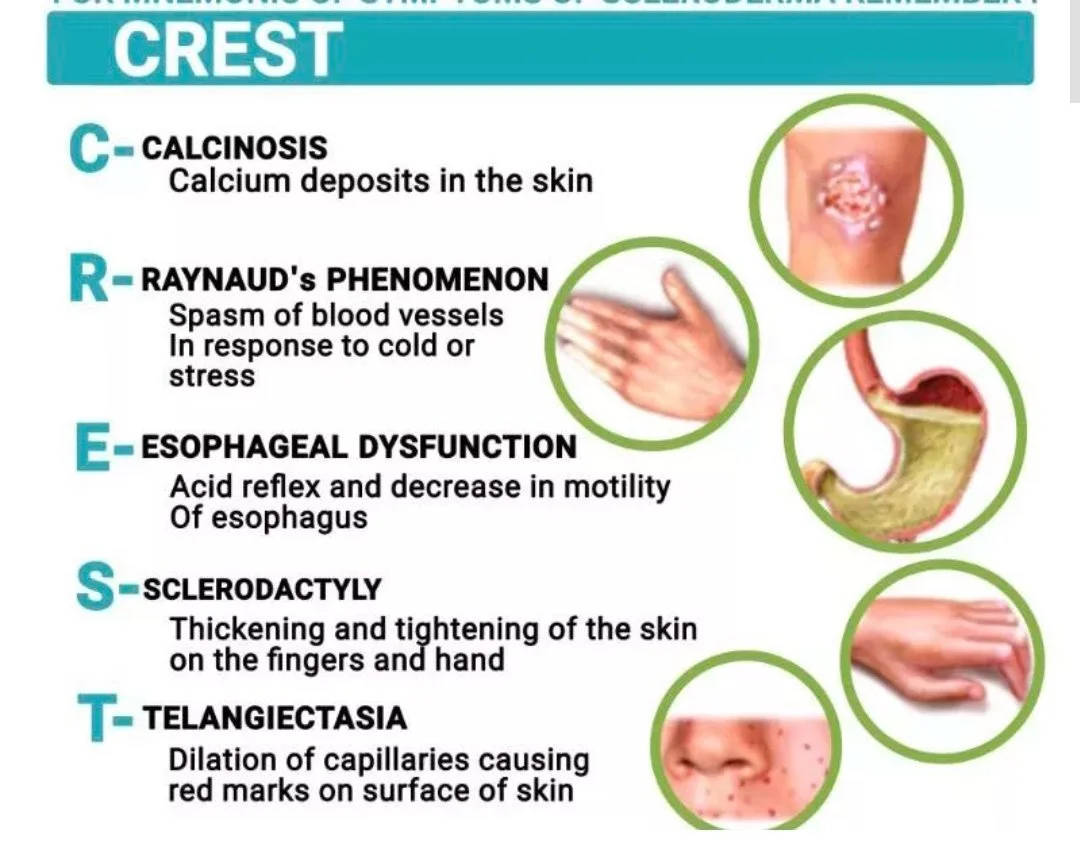
Persons with limited scleroderma do not experience kidney issues. The skin thickening is limited to the fingers, hands, and forearms, and also occasionally the feet and legs. Digestive involvement is limited mainly to the esophagus. Among later difficulties, pulmonary hypertension, which can grow in 20% to 30% of patients, can be potentially severe. In pulmonary hypertension, the arteries from the heart to the lungs constrict and induce high pressure on the right side of the heart, which can eventually lead to right-sided heart failure. Early symptoms of pulmonary hypertension contain chest pain, shortness of breath, and fatigue.
Symptoms of Scleroderma
Scleroderma’s signs and symptoms differ from patient to patient, relying on which regions of the body are involved.
Skin-related signs and symptoms
Almost everyone who has scleroderma feels a hardening and tightening of the skin.
The first regions of the body to be involved are generally the hands, fingers, feet, and face. In some patients, the skin thickening can also affect the upper arms, forearms, abdomen, chest, lower legs, and thighs. Early symptoms may contain swelling and itchiness. The involved skin can evolve lighter or darker in color and may look glossy because of the tightness.
Some patients also feel small red spots, known as telangiectasia, on their hands and faces. Calcium deposits can form under the skin, especially at the fingertips, generating bumps that can be noticed on X-rays.
Raynaud’s phenomenon
Raynaud’s phenomenon is familiar in scleroderma and happens because of an improper and excessive contraction of the small blood vessels in the fingers and toes in reaction to the cold or emotional distress. When this occurs, the digits may turn blue, white, or red, and sense pain or numbness. Raynaud’s phenomenon also can happen in a patient who doesn’t have scleroderma.
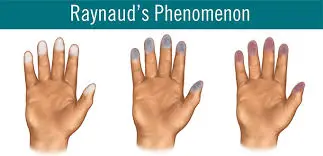
Digestive problems
Scleroderma can involve any region of the digestive system, from the esophagus to the rectum. Relying on which regions of the digestive system are involved, signs and symptoms may contain:
- Heartburn
- Problem in swallowing
- Bloating
- Diarrhea
- Constipation
- Fecal incontinence
- Heart and lung issues
When scleroderma involves the heart or lungs, it can generate shortness of breath, reduced exercise tolerance, and dizziness. Scleroderma can generate scarring in the lung tissues that may result in raising shortness of breath over time. Some medications may assist to delay the progression of this lung injury.
Scleroderma can also generate blood pressure to rise in the circulation that goes between the heart and the lungs. This is known as pulmonary hypertension. In extra to shortness of breath, pulmonary hypertension can also generate extra fluid in the feet, legs, and occasionally near the heart.
When scleroderma involves the heart, heartbeats can evolve irregularly. Heart failure may also happen in some patients.
Causes of Scleroderma
Scleroderma outcomes from overproduction and collection of collagen in body tissues. Collagen is a fibrous kind of protein that makes up your body’s connective tissues, involving your skin.
Doctors don’t know precisely what generates this process to start, but the body’s immune system seems to play a role. Most probably, scleroderma is generated by a combination of factors, involving immune system issues, genetics, and environmental stimuli.
Risk factors
Anyone can obtain scleroderma, but it does happen much more frequently in females than in males. Several combined elements seem to affect the risk of developing scleroderma:
Genetics. A patient who has specific gene variations seems to be more probable to produce scleroderma. This may clarify why a small number of scleroderma patients seem to run in families and why some varieties of scleroderma are more familiar to specific ethnic groups.
Environmental triggers. Study indicates that, in some patient, scleroderma symptoms may be activated by exposure to specific viruses, medications, or drugs. Recounted exposure, like at work, to specific toxic substances or chemicals also may raise the risk of scleroderma. An environmental stimulus is not specified for most patients.
Immune system issues. Scleroderma is thought to be an autoimmune illness. This suggests that it happens in the region because the body’s immune system starts to attack the connective tissues. A patient who has scleroderma may even have symptoms of another autoimmune condition like rheumatoid arthritis, lupus, or Sjogren’s syndrome.
Differential Diagnosis
Several other conditions have symptoms equal to those seen in scleroderma.
These contain:
Eosinophilic fasciitis (EF): This rare condition affects the fascia, the thin connective tissue near the muscles. The fascia evolves swollen, inflamed, and thick. The skin on the legs, arms, neck, abdomen, or feet can be affected. Unlike scleroderma, the fingers are not affected. A skin biopsy differentiates between the two conditions.
Nephrogenic Systemic Fibrosis: An unusual condition of fibrosis of the skin and organs, generated by gadolinium exposure ( used in imaging) in those persons with renal insufficiency.
Generalized scleroderma-like skin thickening: This may happen with graft-versus-host condition, scleromyxedema, porphyria cutanea tarda, and human adjuvant disorder.
Raynaud phenomena: This may happen in isolation, as well as in a region of the scleroderma condition process.
Diagnosis
The diagnosis of scleroderma is not always comfortable. Because it can involve different regions of the body like the joints scleroderma may be initially mistaken for rheumatoid arthritis or lupus.
After examining your family medical record, your doctor or physician will conduct a thorough physical examination. In doing so, he or she will be examining for any of the symptoms noted above, particularly thickening or hardening of the skin near the fingers and toes or discoloration of the skin. If scleroderma is supposed, examinations will be ordered to verify the diagnosis, as well as to define the severity of the condition. These tests may contain:
Blood tests: Raised levels of immune elements, called antinuclear antibodies, are seen in 95% of persons with scleroderma. Although these antibodies are also present in further autoimmune conditions like lupus, testing for them in a potential scleroderma person helps assist with an exact diagnosis.
Pulmonary function tests: These examinations are done to estimate how well the lungs are working. If scleroderma is supposed or has been verified, it is essential to confirm whether or not it has spread to the lungs, where it can generate scar tissue formation. An X-ray or computed tomography (CT scan) may be used to inspect for lung damage.
Electrocardiogram: Scleroderma can generate scarring of the heart tissue, which can conduct to congestive heart failure and impair the electrical activity of the heart. This examination is conducted to notice whether the condition has involved the heart.
Echocardiogram (an ultrasonogram of the heart): This is suggested once every 6 to 12 months to assess for difficulties such as pulmonary hypertension and/or congestive heart failure.
Gastrointestinal tests: Scleroderma can involve the muscles of the esophagus as well as the walls of the intestine. This can generate heartburn and swallowing problems, and can also involve the absorption of nutrients and movement of food via the intestine. An endoscopy (the insertion of a tiny line with a camera on the end) is occasionally performed to view the esophagus and the intestines, and an examination known as manometry can estimate the strength of the esophageal muscles.
Kidney function: When scleroderma involves the kidneys, the outcome can be an increase in blood pressure as well as the leakage of protein into the urine. In its most severe form (known as scleroderma renal crisis), a rapid growth in blood pressure may happen, resulting in kidney failure. Kidney function can be evaluated via blood examinations.
Treatment of Scleroderma
Presently, there is no treatment for scleroderma. Rather, therapy is directed at preventing and managing the symptoms. Because scleroderma can have multiple symptoms, a variety of methods is frequently required to manage the condition effectively.
Skin treatments
For localized scleroderma, topical drugs frequently are beneficial. Moisturizers are used to control the skin from drying out, as well as to manage hardened skin. To enhance blood flow so that sores in the fingers can heal, nitrates like nitroglycerin are defined. Nitrates work by calming the smooth muscles, generating the arteries to dilate (widen). Smooth muscles are those that normally create help blood vessels and some internal organs. Nitrates can have side effects like nausea, dizziness, rapid heartbeat, and blurred vision, so it is essential to consult with your doctor or physician about whether or not they may be good for you.
Digestive remedies
A combination of drugs may be defined to assist a person with heartburn and further digestive problems. These contain over-the-counter and prescribed antacids, proton pump inhibitors (such as Protonix, Prevacid, or Nexium), and H2 receptor blockers (such as Zantac or Pepcid). Proton pump inhibitors work by controlling the proton or acid pump in the stomach from permitting stomach acid to be secreted. H2 receptor blockers function by stopping histamine, a body chemical that facilitates the production of acid in the stomach.
Treatment of lung disease
For a person with scleroderma who has rapidly aggravating pulmonary fibrosis (scarring of the lung tissue), the medication cyclophosphamide (Cytoxan) – a form of chemotherapy – has been confirmed to be helpful in a current NIH analysis. This analysis demonstrated the significance of oral cyclophosphamide in enhancing lung function and the quality of life in a scleroderma person with an interstitial lung condition.
For pulmonary hypertension, the most victorious therapy is a continuous intravenous infusion of epoprostenol (Flolan), a prostaglandin, via a pump. Subcutaneous infusion of treprostinil (Remodulin) a connected prostaglandin is an acceptable alternative. Prostaglandins are hormone-like substances seen in the body that, among further items, asset calm the smooth muscle, and thus dilate blood vessels. Further conditions of therapy that are now FDA-approved for pulmonary hypertension contain oral sildenafil (Revatio ), bosentan (Tracleer ), and inhaled iloprost (Ventavis).
Lung transplant is a viable choice for both extreme (drug refractory) interstitial lung conditions and pulmonary hypertension.
Joint difficulties
For a person with scleroderma who feel joint issues, anti-inflammatory medications(NSAIDs) may be specified. These medications work by decreasing inflammation and therefore pain and swelling. Physical therapy to control joints from contracting can occasionally be useful.
Raynaud’s phenomenon
Useful medications contain vasodilators such as nitroglycerine patches/ointment, calcium channel blockers (Procardia or Norvasc), alpha-blockers, and sildenafil. Anti-platelet medications like aspirin are frequently added. For ischemic digital ulcers, oral agents such as sildenafil (Viagra) or preventive use of bosentan (Tracleer) can be helpful. For fingers with extreme ulceration or impending gangrene, hospitalization for a difficulty of intravenous epoprostenol (Flolan) or alprostadil is appropriate. Infected ulcers require local wound maintenance and an extended period of suitable antibiotics.
Sjgren’s syndrome
Although it cannot be fixed, the symptoms can be reduced. Dry eyes can be managed with synthetic teardrops, and cyclosporine eye drops (Restasis). A dry mouth can be relieved by sipping liquids or chewing gum. In more extreme circumstances of dry mouth, medications that encourage the production of saliva (Evoxac or Salagen) may be defined.
Kidney problems
Relying on the severity of the condition, kidney issues related to scleroderma can be controlled and managed using drugs (particularly Angiotensin Converting Enzyme (ACE) inhibitors) and dialysis.
Management of scleroderma
In extra to bringing specified drugs accurately and regularly, there are many actions a patient with scleroderma can bring to better manage the condition. These contain:
Exercise
Regular exercise will not only assist enhance your overall physical and spiritual well-being, but it will also assist to maintain your joints flexibly and enhance circulation. Confer your doctor or physical therapist for proper exercises.
Joint protection
When your joints are damaged, avoid lifting heavy things or conducting chores that may put a strain on them, therefore risking additional injury. A physical therapist can assist you to learn new methods to complete daily activities without putting undue strain on your joints.
Skin protection
Carrying appropriate precautions and maintenance of your skin can be useful not only for symptoms of Raynaud’s phenomenon but also in bringing care of the dry, dense patches of skin that result from localized scleroderma. There are many methods to perform this, involving:
During the colder months, be certain to dress properly. Maintaining your body warm and covered from the cold weather with a hat, boots, gloves and a scarf will assist maintain the blood vessels in your extremities open and your circulation flowing.
Wear multiple thin layers. These will maintain you warmer than wearing one dense layer.
Wear loose-fitting boots or shoes to maintain the blood supply moving to your feet.
Place a humidifier in your house to assist maintain the air moist.
Use soaps and lotions that are designed particularly for dry skin.
Diet
Aside from consuming healthy foods to obtain the appropriate quantities of vitamins and nutrients, it is essential to eat foods that do not exacerbate existing stomach issues. Methods to do this involve:
Avoiding foods that generate heartburn.
Drinking water or another liquid to soften food also.
Consuming high-fiber foods to cut down on constipation.
Consuming more, or fewer meals as opposed to three large meals. This allows the body to digest food more efficiently. If you eat a large meal, wait at minor four hours before lying down.
Lifting the head of your bed approximately six inches by putting blocks or bricks beneath it. This will contain stomach acid from entering the esophagus while you are sleeping.
Dental care
For those persons with scleroderma who also have Sjgren’s syndrome, good dental care is important. Sjgren’s syndrome raises the risk of forming cavities and tooth decay.
Stress management
Because the results of stress can play a role in decreasing your blood flow, as well as involving many further parts of your emotions and health, it is essential to learn to manage or decrease stress. This can be done by managing the subsequent steps:
- Obtaining appropriate sleep and rest.
- Avoiding stressful conditions when likely.
- Consuming a healthy diet.
- Learning forms to maintain anxieties and fears.
- Exercising.
Although no treatment has been seen for scleroderma, the condition is very frequently gradually progressive and manageable, and a person who has it may conduct a healthy and effective life. Like many further needs, education regarding scleroderma and local support groups can be the most significant tools for controlling the condition and decreasing the risk of other difficulties.
Physiotherapy treatment
Physical therapy can be very useful in the treatment of scleroderma. Physical therapists/ Physiotherapists, together with further health professionals like Occupational Therapists, can create a schedule of routine stretching and mild exercise to assist:
- Manage pain
- Enhance strength
- Enhance/support mobility
- Minimize joint contractures
- Enhance circulation. Education re protecting vulnerable skin regions and maintaining their warm
- Enhance/maintain the performance of movements of daily living to promote independence
Further health professionals like psychologists, and social workers may play a function in personal care.
Dentists, orthodontists, and speech therapists may be interested in the management of difficulties that derive from the thickening of mouth and face tissues.
Analysis regarding the most useful management and therapy is ongoing.
Surgical and further procedures
Stem cell transplants might be a choice for a person who has extreme symptoms that haven’t reacted to more-common therapies. If the lungs or kidneys have been hardly damaged, organ transplants might be regarded.
Lifestyle and home remedies
You can bring several measures to assist control your symptoms of scleroderma:
Stay active. Exercise maintains your body’s flexibility, enhances circulation, and reduces stiffness. Range-of-motion activities can assist to maintain your skin and joint flexibility. This is always essential, but particularly early in the condition course.
Protect your skin. Bring the right care to dry or stiff skin by using lotion and sunscreen daily. Avoid hot baths and showers and disclosure to vigorous soaps and household chemicals, which can aggravate and distant dry out your skin.
Don’t smoke. Nicotine generates blood vessels to contract, creating Raynaud’s condition more harmful. Smoking can also generate permanent narrowing of the blood vessels, and generate or exacerbate lung issues. Quitting smoking is hard to ask your doctor for an asset.
Manage heartburn. Avoid foods that deliver you heartburn or gas. Also, avoid late-night meals. Raise the head of your bed to maintain stomach acid from backing up into your esophagus as you sleep. Antacids may assist to reduce symptoms.
Cover yourself from the cold. Wear warm mittens for safety anytime your hands are disclosed to cold even when you bear into a freezer. It is also essential to maintain your core body temperature warm to assist control Raynaud’s symptoms. When you’re outside in the cold, wear warm boots, protect your face and head, and wear coatings of warm clothing.
Complications
Scleroderma difficulties vary from mild to severe and can involve the:
Fingertips. In systemic sclerosis, Raynaud’s phenomenon can evolve so severely that the limited blood flow permanently impairs the tissue at the fingertips, generating pits or skin sores. In some circumstances, the tissue on the fingertips may die.
Lungs. Scarring of lung tissue can affect your capability to breathe and exercise tolerance. You may also generate high blood pressure in the arteries to your lungs.
Kidneys. A severe kidney difficulty (scleroderma renal crisis) affects a sudden raise in blood pressure and quick kidney failure. Immediate treatment of this disease is essential to preserve kidney function.
Heart. Scarring of heart tissue raises your risk of abnormal heartbeats and congestive heart failure. Scleroderma can also generate inflammation of the membranous sac covering your heart.
Teeth. Extreme tightening of facial skin can generate your mouth to evolve smaller and narrower, which may cause it hard to brush your teeth or to have them professionally cleaned. A person who has scleroderma frequently doesn’t create normal quantities of saliva, so the risk of dental decay rises even more.
Digestive system. Digestive issues associated with scleroderma can lead to heartburn and problem swallowing. It can also generate episodes of bloating, cramps, constipation, or diarrhea. Some people who have scleroderma may also have issues absorbing nutrients due to the overgrowth of bacteria in the intestine.
Joints. The skin over joints can evolve so tight that it limits joint flexibility and motion, especially in the hands.
Prognosis
In some patients, symptoms evolve fast for the first few years and continue to get more harmful. Yet, in most patients, the condition brings more harm only gradually.
A patient who has just skin symptoms has a better outlook. Overall (systemic) scleroderma can show to.
- Heart failure
- Scarring of the lungs tissue, known as pulmonary fibrosis
- High blood pressure in the lungs (pulmonary hypertension)
- Kidney failure (scleroderma renal crisis)
- Issues absorbing nutrients from food
- Cancer
FAQ
Is scleroderma a serious disease?
It is the numerous fatal of all rheumatologic conditions. Systemic scleroderma is especially unpredictable although most patients can be categorized into one of four various general patterns of the condition.
Can scleroderma be treated?
No treatment can cure or prevent the overproduction of collagen which is typical of scleroderma. But a type of therapy can assist control symptoms and control difficulties
What is end-stage scleroderma?
This kind of scleroderma is generally accompanied by shortness of breath, a persistent cough, and the incapability to conduct routine physical activities. Last-stage scleroderma is mostly associated with complications such as pulmonary fibrosis and/or pulmonary hypertension, both of which can be life-threatening.
What is the lifespan of scleroderma?
It is commonly thought that patients with localized scleroderma may live a fit and long life with few symptoms solely. Whereas, patients with systemic variety may have a quick span of life from 5 to 10 years.
Can Ayurveda cure scleroderma?
Ayurvedic therapy of Scleroderma affects treatments that include the elimination of the root reason of the disease. Therapies are lepa, parisheka, abhyanga, avagahana, and upanaha. The therapy also contains Shodhana therapy & Shamana therapy.

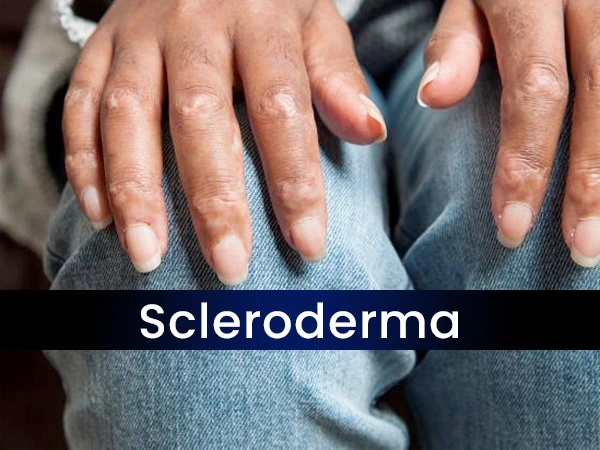
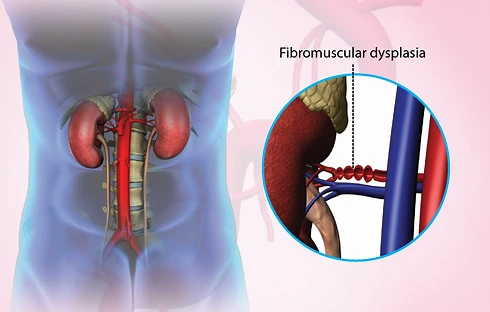
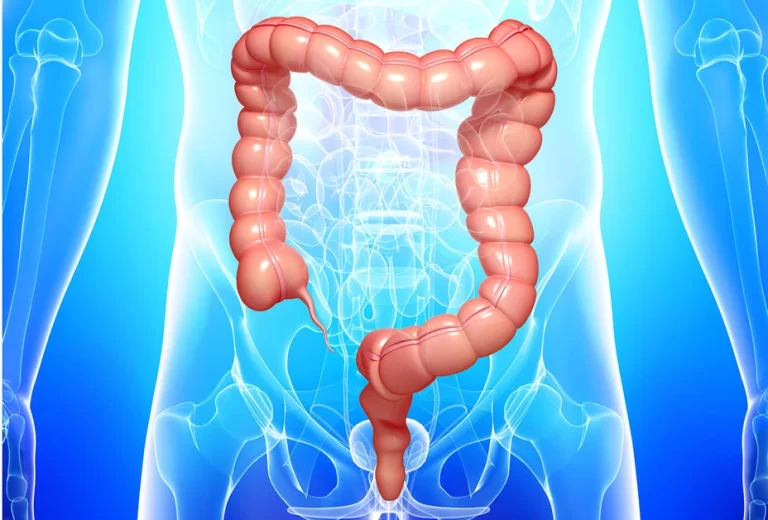



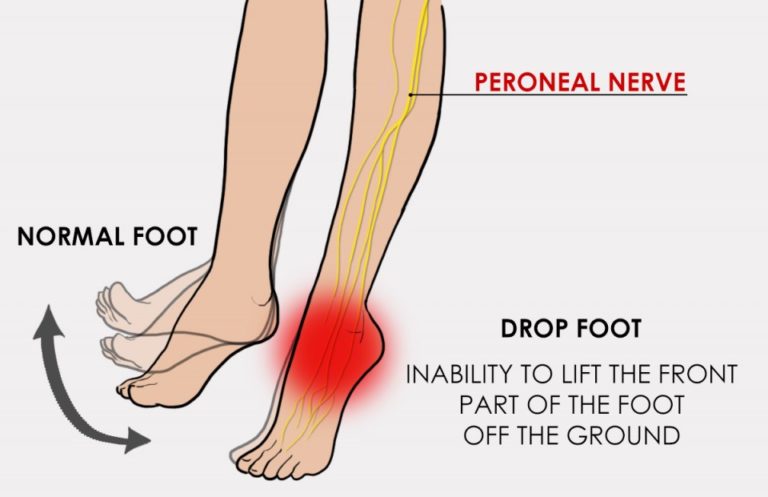
One Comment